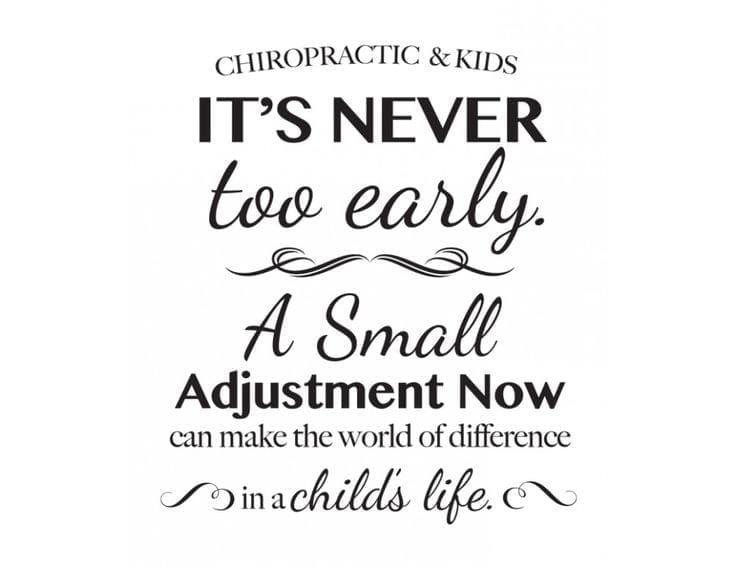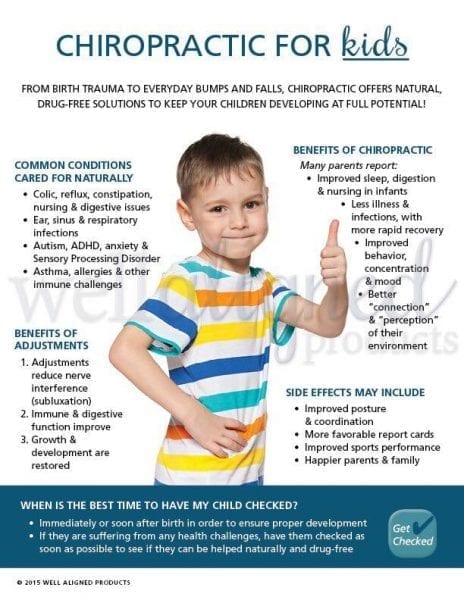
The Nervous System Controls Everything
The central nervous system consists of the brain and the spinal cord. From the spinal cord are nerves that go to every organ, gland, tissue, muscle and cell of the body. The nervous system is setup much like a big fuse box, and if there is a “blown fuse” or Subluxation the child could react with constipation, colic, bed wetting, ear infections, torticollis, fussiness, trouble sleeping, reflux and so on. Pediatric chiropractors can help with many childhood conditions, but our focus is not on treating disease or disorders. Quite the opposite, our focus is on allowing the nervous system to function without interference (Subluxation) or to remove the “blown fuse.
Spinal adjustments for infants and young children involve very light fingertip pressure to correct spinal misalignments. This amount of “force” is often not more than a finger touch. This is usually sufficient to restore mobility to spinal joints which have become locked and are causing interference to the normal nervous system function. Occasionally, the adjustments will make a ‘popping’ sound when the spinal joints are moved; however, this is not always heard when children’s spines are adjusted. Other techniques involve the use of hand-held instruments which offer specific and gentle correction.
Does it hurt?
In general, chiropractic care for children is painless, except in cases where the child has an actual injury. In these areas, the child may be sensitive to touch; however, once the adjustment has been made and the area can heal more effectively, the sensitivity is alleviated. Overall, most parents report that their children enjoy their spinal adjustments, and that they look forward to their next visit.
How long will it take?
A child’s spine will generally respond much faster than an adult’s spine to chiropractic adjustment, and will often require only a few adjustments to restore normal function. The actual number of adjustments will vary depending on many factors such as the length of time the problem has been present.
Is it safe?
The risks of a child suffering notable injury from a spinal adjustment are extremely minimal. Chiropractors have been adjusting children’s spines for more than 100 years and have an excellent safety record.
A recent study done by the International Chiropractic Pediatric Association (ICPA) in the United States, Canada, and Europe showed that only a few children (out of more than 10,000 visits) experienced minor discomfort and fussiness. The remaining children in the study had no adverse reactions to the adjustment. These preliminary data tells us that chiropractic care for children may be one of the safest forms of health care available. Australian ICPA chiropractors will be participating in a similar study as well.
How can I tell if my child has spinal problems?
Unless a child has an obvious problem it can be difficult for a parent to recognise when a child’s spine is not working correctly. There are some signs which can indicate spinal problems. These include:
- disturbed sleeping patterns
- breastfeeding difficulties in the very young
- restricted head or neck movement to one side
- one shoulder higher than the other
Common childhood disorders can also be linked with spinal dysfunction, these include:
- recurrent ear infections
- persistent sore throats and colds
- colic/reflux
- asthma
- scoliosis
- headaches
- bedwetting and/or constipation
- growing pains
- ADHD
One of the most common reasons for parents to seek chiropractic care for their child is physical trauma from an injury of some sort. The spinal misalignments that may occur at the time of the injury will not necessarily result in immediate pain or symptoms. In addition to physical stress, parents should be aware that emotional and chemical stress affect the child’s nervous system and may also warrant a spinal check up.
Regular chiropractic checkups can identify potential spinal dysfunction resulting from these stresses, and chiropractic adjustments may help to enhance future function and well-being.

